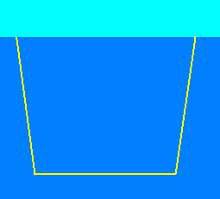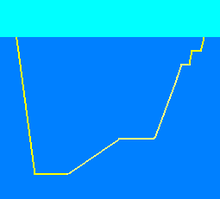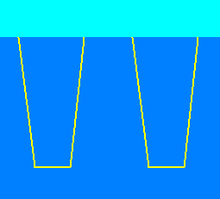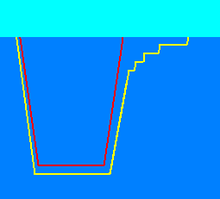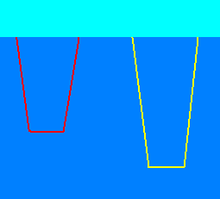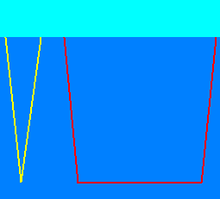- Dive profile
-
A dive profile is a two dimensional graphical representation of a dive showing depth and time.
It is useful as an indication of the risks of decompression sickness and oxygen toxicity and also the volume of open-circuit breathing gas needed for a planned dive as these depend in part upon the depth and duration of the dive. A dive profile diagram is often drawn with time running from left to right and depth increasing down the page.
Contents
Planning and monitoring decompression
For planning and monitoring of nitrogen absorption, the data usually consists of the maximum depth reached during the dive and the length of time underwater. For repetitive dives it also includes the "surface interval", or the time spent above the water between the previous dive and the start of the current dive. This information is used to calculate the amount of residual nitrogen build-up in the diver's tissues after completing a dive.
Types of dive profile
Some types of dive profile have been named.
Square profile
The diver descends directly to maximum depth, spends most of the dive at maximum depth and then ascends directly at a safe rate. The sides of the "square" are not truly vertical due to the need for a slow descent to avoid barotrauma and a slow ascent rate to avoid decompression sickness.[1]
This type of profile is common for dives at sites where there is a flat sea-bed. It is the most demanding profile for decompression for a given maximum depth and time because absorption continues at maximum rate for most of the dive. Decompression tables assume the diver has done a square profile.[2]
Multi-level diving
Where the dive site and underwater topography permit, divers often prefer to do a more triangular than square dive profile; they descend to maximum depth and slowly ascend throughout the dive.
A slow ascent, and therefore slow pressure reduction, is a good decompression practice. When using a dive computer this type of profile often results in no need for deliberate decompression stops. Dive computers, unlike decompression tables, measure depth and time at short intervals and calculate the exact decompression stops required, which for a triangular profile will be less than the square profile with the same maximum depth and duration.[3][4]
Repetitive diving
Repetitive diving occurs when two dives are separated by a short surface interval, during which the diver has not completely desaturated from the first dive. The gas loading from the first dive must then be taken into account when determining no stop times and decompression requirements for the second dive.
At the surface the absorbed inert gases from the dive are eliminated as time passes. When completely "desaturated" the levels of those gases in the diver's body have returned to those normal at atmospheric pressure. The interval to complete desaturation varies depending upon factors such as the depth and duration of the dive, the altitude of the dive, the gas mixtures breathed on the dive, and the decompression strategy used. The maximum interval until desaturation on the BSAC 88 dive table is 16 hours.[5]
Multiple decompressions per day over multiple days can increase the risk of decompression sickness because of the build up of asymptomatic bubbles, which reduce the rate of off-gassing and are not accounted for in most decompression algorithms.[6]
Decompression profile
When no stop depth or time limits are exceeded the diver must do decompression stops to reduce the risk of decompression sickness.[7][8] Stops when breathing gases containing nitrogen tend to be in shallow water, usually in 3-metre (10 ft) steps. Stops when breathing helium mixes tend to be in deeper water. The duration of the shallower stops is more than the duration of deeper stops. Stops tend to make a dive profile triangular.
Reverse profile
Reverse profiles occur when a repeat dive is deeper than the earlier dive. Many diver training agencies discourage reverse profiles because they are not the best way to plan for safe decompression; it is better to do the deeper dive first when the body's tissues hold less absorbed nitrogen. The American Academy of Underwater Sciences workshop concluded there was no reason for the diving communities to prohibit reverse dive profiles for no-decompression dives less than 40 metres (130 ft) deep and depth differentials less than 12 metres (40 ft).[9]
Saw tooth profile
In a saw tooth profile the diver ascends and descends a number of times during the dive. Each ascent and descent increases the risk of decompression sickness.[2][10][11]
Bounce profile
With a bounce dive the diver descends directly to the maximum depth, spends very little time at maximum depth and ascends directly at a safe rate to the surface. Bounce dives are often described in professional diving as the opposite to saturation dives where the diver lives at pressure for very long periods before ascending.
Ambient pressure on the surface
Sometimes changes in ambient pressure, while diver is on the surface, are drawn on a dive profile. The changes may be caused by flying, land travel involving changes in altitude, or atmospheric pressure changes due to weather.[12] Ambient pressure changes before and after diving can be significant in decompression planning.[13] Starting dives at altitude also has an impact on dive and decompression planning.[14][15][16]
References
- ^ Lang, M.A. and Egstrom, G.H. (1990). Proceedings of the AAUS Biomechanics of Safe Ascents Workshop. Woods Hole, MA: American Academy of Underwater Sciences. pp. 220. http://archive.rubicon-foundation.org/4241. Retrieved 2008-04-25.
- ^ a b Sport Diving, British Sub Aqua Club, ISBN 0091638313, page 110
- ^ Lang, M.A. and Hamilton, Jr R.W. (1989). Proceedings of the AAUS Dive Computer Workshop. USC Catalina Marine Science Center: American Academy of Underwater Sciences. pp. 231. http://archive.rubicon-foundation.org/4242. Retrieved 2008-04-25.
- ^ Learn to Scuba Dive UK PADI Diving Equipment UK Dive Trips
- ^ The BSAC Nitrox Decompression Tables, Surface Interval Table, Page 5
- ^ Lang, M.A. and Vann, R.D. (1991). Proceedings of the AAUS Repetitive Diving Workshop. Duke University, Durham, NC: American Academy of Underwater Sciences. pp. 339. http://archive.rubicon-foundation.org/4243. Retrieved 2008-04-25.
- ^ Boycott, A. E.; G. C. C. Damant, J. S. Haldane. (1908). "Prevention of compressed air illness". J. Hygiene 8 (03): 342–443. doi:10.1017/S0022172400003399. PMC 2167126. PMID 20474365. http://archive.rubicon-foundation.org/7489. Retrieved 2008-08-06.
- ^ Bühlmann, Albert A. (1984). Decompression-Decompression Sickness. Berlin New York: Springer-Verlag. ISBN 0387133089.
- ^ Lang, M.A. and Lehner, C.E. (2000). Proceedings of Reverse Dive Profiles Workshop. Smithsonian Institution, Washington D.C.: American Academy of Underwater Sciences. pp. 295. http://archive.rubicon-foundation.org/4244. Retrieved 2008-04-25.
- ^ e-med Private Medical Services - Scuba Diving Medical Advice
- ^ Scottish Diving Medicine - Reducing the Risk of DCI
- ^ BSAC '88 Decompression Tables Levels 1 to 4
- ^ Brubakk, A. O.; T. S. Neuman (2003). Bennett and Elliott's physiology and medicine of diving, 5th Rev ed.. United States: Saunders Ltd.. pp. 800. ISBN 0702025712.
- ^ Bassett, B. E. (1979). "And yet another approach to the problems of Altitude Diving and Flying After Diving.". Decompression in Depth Symposia. Santa Ana, California: Diving Science & Technology Corp.. pp. 38–48. http://archive.rubicon-foundation.org/4230. Retrieved 2008-04-25.
- ^ Bassett, B. E. (1982). "Decompression Procedures for Flying After Diving, and Diving at Altitudes above Sea Level". US Air Force Technical Report SAM-TR-82-47. http://archive.rubicon-foundation.org/4531. Retrieved 2008-04-25.
- ^ Egi S. M., Brubank A. O. (1995). "Diving at altitude: a review of decompression strategies". Undersea Hyperb Med 22 (3): 281–300. ISSN 1066-2936. OCLC 26915585. PMID 7580768. http://archive.rubicon-foundation.org/2194. Retrieved 2008-04-25.
Categories:
Wikimedia Foundation. 2010.

